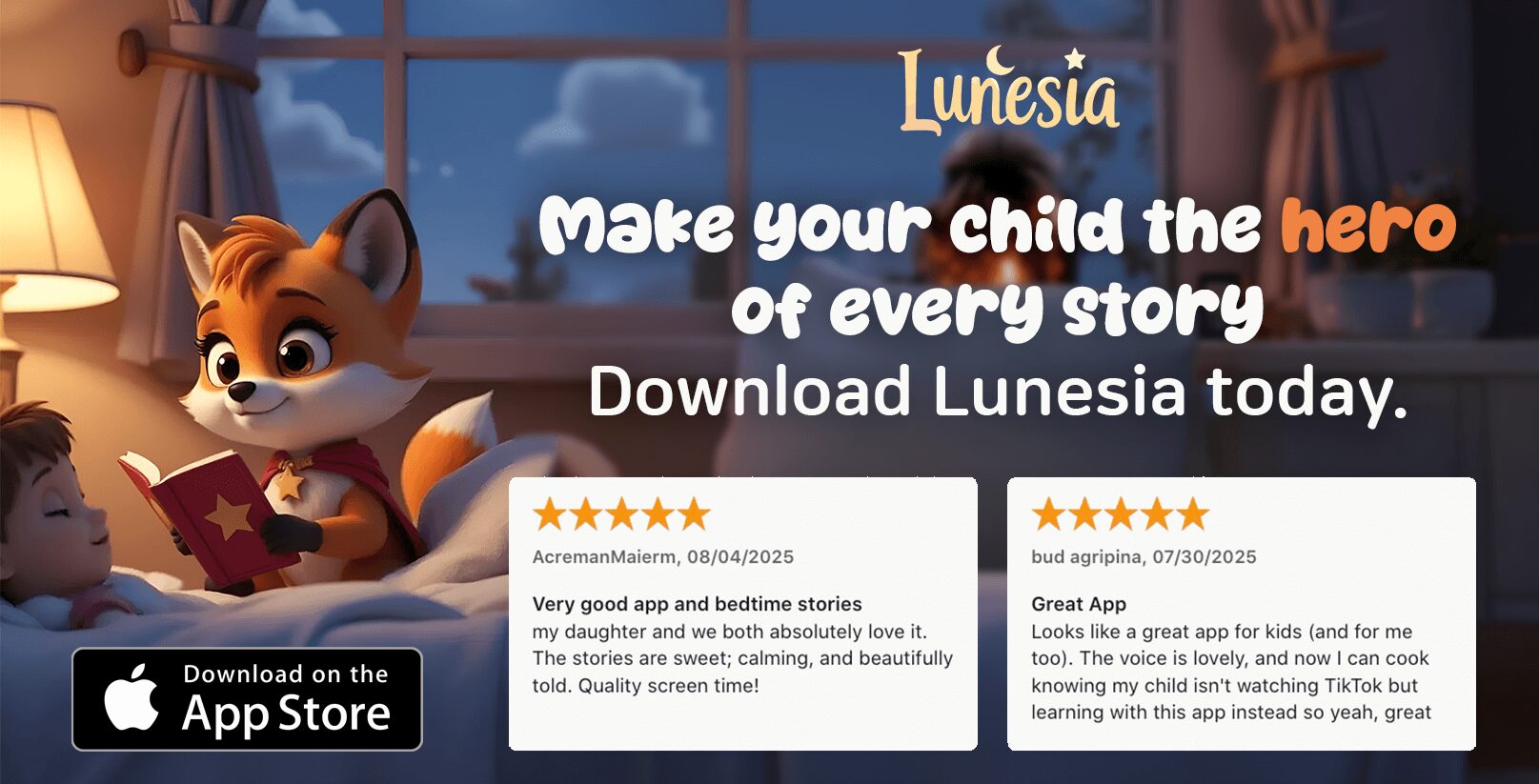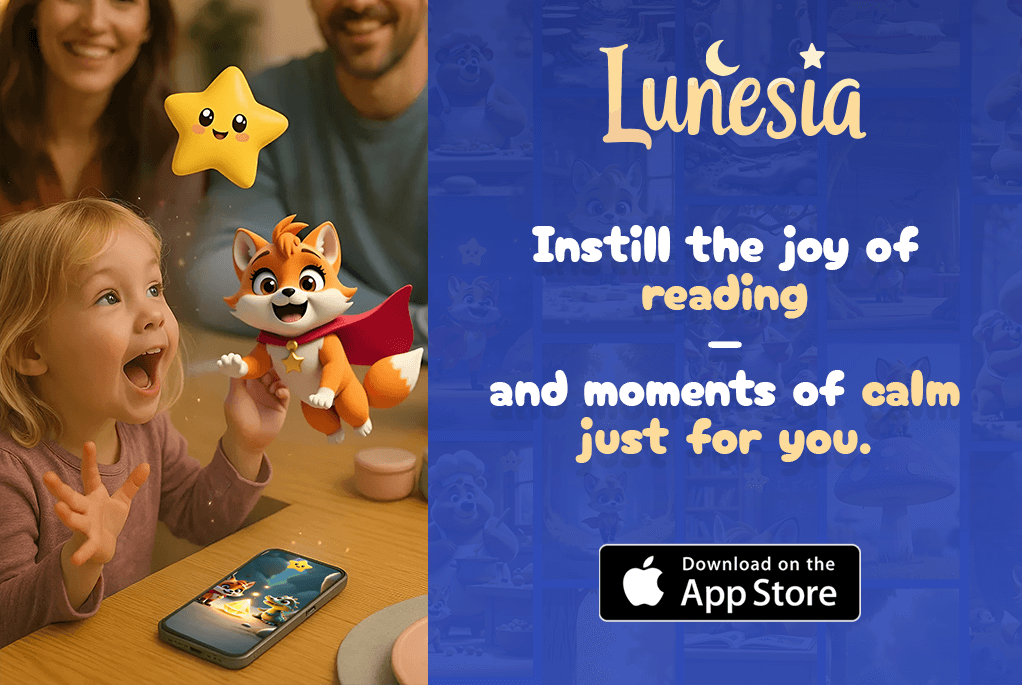Have you ever wondered how some children seem to tackle challenges with ease, while others struggle to find a solution? As a parent, it’s natural to want to help your child develop the skills they need to succeed. Can interactive stories be the key to unlocking your child’s problem-solving potential?
I’ve seen firsthand how interactive storytelling can transform a child’s approach to obstacles. By engaging with stories that require decision-making and critical thinking, children develop essential problem-solving skills. This article will explore seven ways interactive stories can boost your child’s ability to think critically and overcome challenges.
In the following sections, we’ll dive into the science-backed benefits of story-based learning and how it prepares children for real-world challenges. By the end, you’ll have a deeper understanding of how to harness the power of interactive stories to support your child’s cognitive development.
The Critical Connection Between Stories and Cognitive Development
Engaging with stories is not just entertainment for children; it’s a critical component of their cognitive development. When children listen to or read stories, their brains are actively processing information, making connections between events, and developing problem-solving skills. This narrative engagement is fundamental to how children learn and understand the world around them.
How Children Process Information Through Narrative
Children’s brains are naturally wired to respond to narratives. When they engage with stories, they are not just passively listening; they are actively making sense of the information presented. Narrative structures help children organize information, create meaningful connections, and develop a deeper understanding of the story’s context. This process enhances their ability to think critically and solve problems effectively.
Research has shown that narrative-based learning stimulates multiple areas of the brain simultaneously, creating stronger neural pathways for problem-solving skills (PMC7291864). By engaging with stories, children develop their critical thinking skills, learning to analyze situations, predict outcomes, and make informed decisions.
The Science Behind Story-Based Learning
The science behind story-based learning reveals that narratives serve as mental models that children can reference when facing real-world problems. As children progress through different developmental stages, their ability to process stories evolves from concrete understanding to abstract thinking and application. Interactive elements in stories create a “productive struggle” that is essential for cognitive growth and problem-solving development.
By connecting story-based learning to educational theories about knowledge construction and critical thinking development, we can see how stories play a vital role in enhancing children’s cognitive abilities. This approach not only fosters a deeper love for learning but also equips children with the skills necessary to navigate complex situations and challenges.
Understanding Problem-Solving Skills in Child Development
Problem-solving skills are a cornerstone of child development, influencing critical thinking and decision-making. As children grow, their ability to tackle problems effectively is crucial for their intellectual and emotional development.
Nurturing children’s problem-solving abilities is essential for their cognitive development. These capabilities are pivotal in bolstering critical thinking, making well-informed choices, and sparking creative thought—all of which are instrumental across life’s journey.
Key Components of Effective Problem-Solving
Effective problem-solving skills in children comprise several key components. These include:
- Identifying problems and understanding their context
- Analyzing the problem to determine the root cause
- Generating creative solutions
- Evaluating the effectiveness of these solutions
By breaking down the problem-solving process into these manageable parts, children can develop a systematic approach to tackling challenges. This structured method helps in building their confidence and enhancing their ability to handle complex problems.
“The way we talk to our children becomes the way they talk to themselves.” – Peggy O’Mara
Encouraging children to verbalize their thought process as they solve problems can significantly enhance their critical thinking skills. This practice not only helps in clarifying their thoughts but also in developing a more logical and methodical approach to problem-solving.
Developmental Milestones in Critical Thinking
Critical thinking develops over time, with children achieving various milestones as they mature. Understanding these milestones can help parents and educators support children’s development more effectively.
| Age Range | Developmental Milestones |
|---|---|
| Toddlerhood (1-3 years) | Beginning to understand cause and effect, experimenting with simple problem-solving |
| Early Childhood (4-6 years) | Developing the ability to think more logically, starting to consider multiple solutions |
| Middle Childhood (7-10 years) | Enhancing analytical skills, able to evaluate simple problems more effectively |
By recognizing these developmental milestones, parents can tailor their guidance to support their child’s growing problem-solving abilities, providing appropriate challenges and encouragement along the way.
1. Interactive Stories Encourage Decision-Making and Consequences
By engaging with interactive stories, children can develop critical thinking skills through making choices and experiencing outcomes. This interactive process helps kids understand the consequences of their decisions in a safe and controlled environment.
Interactive stories, especially those with a choose-your-own-adventure style, provide a unique opportunity for children to practice decision-making. These stories present various scenarios where kids must weigh their options, consider potential outcomes, and make thoughtful choices.
Cause and Effect Learning
Choose-your-own-adventure style stories are particularly effective in teaching cause-and-effect relationships. By making decisions and witnessing the consequences of those choices, children learn that their actions have meaningful impacts. For instance, a story might show how a character’s friendship changes based on the choices made throughout the narrative.
- Making decisions at critical story junctures helps children develop analytical thinking.
- Understanding the consequences of choices enhances their ability to predict outcomes.
- These stories help children become comfortable with making decisions under uncertainty.
Building Analytical Thinking
Decision trees in interactive stories mirror real-life decision-making processes, providing children with mental models they can apply to their own challenges. As children navigate through these stories, they learn to evaluate options, anticipate potential outcomes, and make informed decisions.
For example, an interactive story might present a scenario where a character needs to decide whether to share a toy or keep it. The story could then branch out based on the child’s choice, showing the consequences of that decision on the character’s relationships and reputation.
To further enhance the learning experience, parents can look for interactive stories that feature decision-making scenarios appropriate for their child’s developmental stage. Some recommended apps and platforms offer a range of interactive fiction tailored to different age groups.
2. Character Perspective-Taking Builds Empathy and Solution Finding
When children engage with interactive stories, they develop a crucial skill: the ability to see things from different perspectives. This skill is fundamental in building empathy and enhancing problem-solving abilities. As children navigate through stories, they encounter various characters facing different challenges, allowing them to understand and relate to diverse viewpoints.
Walking in Different Shoes: The Empathy Connection
Empathy is a critical component of effective problem-solving. When children can put themselves in a character’s shoes, they begin to understand the character’s motivations, fears, and desires. This empathetic connection enables children to approach problems with a more nuanced perspective, considering multiple factors and potential outcomes. By engaging with characters’ experiences, children develop a deeper understanding of how different people might tackle the same problem in various ways.
For instance, a story might present a character facing a moral dilemma. As children consider the character’s options and consequences, they develop their critical thinking skills. They learn to weigh the pros and cons of different actions, fostering a more comprehensive approach to problem-solving.
Using Multiple Perspectives to Solve Story Challenges
Interactive stories often present complex challenges that require characters to collaborate or consider alternative viewpoints. By exploring these narratives, children learn to analyze problems from multiple angles, developing more creative and effective solutions. This ability to see problems from different perspectives is a valuable skill that translates to real-world situations, helping children navigate social conflicts and academic challenges.
To illustrate this, let’s consider a comparison of different problem-solving approaches:
| Problem-Solving Approach | Description | Benefits |
|---|---|---|
| Single Perspective | Focusing on one viewpoint or solution | Quick decision-making |
| Multi-Perspective | Considering various viewpoints and solutions | More comprehensive understanding, creative solutions |
| Collaborative | Working together with others to find a solution | Enhanced teamwork, diverse insights |
By engaging with interactive stories and exploring different characters’ perspectives, children can develop a robust set of problem-solving skills. As parents, you can further enhance this development by discussing the stories with your children, asking open-ended questions, and encouraging them to consider alternative solutions.
3. Interactive Storytelling Develops Logical Reasoning Skills
By engaging with interactive stories, children can develop their ability to think logically and solve problems more effectively. Interactive storytelling requires children to follow a narrative that often involves complex sequences and cause-and-effect relationships, thereby strengthening their sequential reasoning abilities.
Following Story Paths and Predicting Outcomes
One of the key benefits of interactive stories is that they encourage children to predict outcomes based on the information available to them. This process helps develop both deductive and inductive reasoning skills, which are essential for effective problem-solving. As children navigate through the story, they learn to make informed decisions and understand the consequences of their choices.
How Narrative Puzzles Strengthen Sequential Thinking
Narrative puzzles embedded within interactive stories challenge children to connect clues, identify patterns, and draw logical conclusions. This not only enhances their problem-solving skills but also improves their ability to distinguish between relevant and irrelevant information. By keeping track of multiple narrative threads, children improve their working memory and executive function, skills that are crucial for academic success, particularly in subjects like math and science.
Some ways interactive stories develop logical reasoning include:
- Encouraging children to follow logical sequences and understand cause-and-effect relationships.
- Developing deductive and inductive reasoning skills through predicting story outcomes.
- Enhancing problem-solving abilities by challenging children with narrative puzzles.
- Improving working memory and executive function by tracking multiple narrative threads.
For different age groups, there are various interactive stories that excel at developing logical reasoning skills. For younger children, stories with simple cause-and-effect relationships can be beneficial, while older children can be challenged with more complex narratives and puzzles.
4. Collaborative Story Creation Enhances Problem-Solving Through Teamwork
Collaborative storytelling is a powerful tool that enhances problem-solving skills in children by encouraging teamwork and creative thinking. When children work together to create a story, they learn to share ideas, negotiate plot twists, and resolve conflicts – all essential skills for effective problem-solving.

Group Storytelling Activities for Families
Engaging in group storytelling activities is an excellent way for families to spend quality time together while developing problem-solving skills. Some fun activities include:
- Creating a story together, with each family member adding a sentence or paragraph
- Using prompts or themes to inspire the story
- Taking turns to decide the direction of the story
These activities encourage children to build upon each other’s ideas, fostering a collaborative environment that promotes effective problem-solving.
Negotiating Story Elements and Resolutions Together
As children work together to create a story, they must negotiate story elements and resolutions. This process teaches them to articulate their reasoning, listen to others’ perspectives, and evaluate multiple possible solutions. By doing so, they develop essential problem-solving skills that will benefit them throughout their lives.
By engaging in collaborative storytelling, children can improve their ability to work together, share ideas, and resolve conflicts – all while having fun creating a story together.
5. Digital Interactive Stories Combine Technology and Critical Thinking
As a parent, you’re likely curious about how digital interactive stories can enhance your child’s critical thinking and problem-solving abilities. The integration of technology and narrative creation has opened up new avenues for kids to develop their problem-solving skills in an engaging and interactive manner.
Digital interactive stories offer a unique advantage in problem-solving development by creating complex, responsive narrative environments that challenge children to make decisions and face consequences. Through platforms like Scratch, which merge block-based coding with narrative creation, kids gain an opportunity to enrich their solving skills while delving into the realm of programming logic.
Age-Appropriate Apps and Platforms for Interactive Fiction
When it comes to selecting digital interactive stories, it’s essential to choose age-appropriate apps and platforms. Developers like Choice of Games offer a range of interactive text-based games suitable for different age groups, from younger children to teens. Some popular options include:
- Apps designed for younger children, focusing on basic decision-making and consequence recognition
- Platforms geared towards older kids, offering more complex narratives and challenging problem-solving scenarios
When selecting apps, it’s crucial to read reviews and understand the content to ensure it aligns with your child’s developmental stage.
Balancing Screen Time with Quality Problem-Solving Content
While digital interactive stories offer numerous benefits, it’s vital to strike a balance between screen time and other activities. To maximize the educational benefits, parents should:
- Monitor the quality of digital interactive stories and choose those that focus on problem-solving and critical thinking
- Engage in discussions with their children about the stories, exploring the decisions made and the consequences faced
- Encourage real-world connections by relating the problem-solving strategies used in the stories to everyday challenges
By doing so, parents can ensure that digital interactive stories become a valuable tool in their child’s cognitive development, enhancing their critical thinking and problem-solving skills.
6. Role-Playing Story Elements Teaches Real-World Problem Resolution
Through role-playing, children can internalize problem-solving strategies from interactive stories and apply them to real-life situations. Engaging in role-play scenarios is an excellent method to hone problem-solving skills among youngsters. Such role-playing exercises solidify understanding about problem solving while presenting potential solutions for consideration.
Acting Out Scenarios from Interactive Stories
Acting out scenarios from interactive stories helps children internalize problem-solving strategies and practice applying them in simulated real-world situations. This process makes abstract concepts concrete and allows children to rehearse how they would manage real situations, such as handling customer rushes or sorting out service-related dilemmas.
Transferring Story Solutions to Everyday Challenges
Role-playing story elements creates a bridge between narrative problem-solving and real-life application. By adapting story solutions to slightly different scenarios or challenges, children practice flexible thinking. The emotional engagement of role-play enhances memory retention of problem-solving strategies, making them more accessible when facing real challenges.
| Role-Playing Activity | Problem-Solving Skill Developed | Real-Life Application |
|---|---|---|
| Acting out customer service scenarios | Conflict resolution | Handling customer complaints |
| Role-playing group projects | Collaboration and teamwork | Working on team projects at school |
| Simulating real-life dilemmas | Decision-making and critical thinking | Making informed decisions in daily life |
To create a safe and supportive role-playing environment, parents should encourage children to experiment with different problem-solving approaches. This can be achieved by facilitating role-playing activities that extend the learning from interactive stories into physical, embodied experiences. By doing so, children will develop essential problem-solving skills that will benefit them throughout their lives.
7. Interactive Stories with Multiple Endings Develop Flexible Thinking
Interactive stories with multiple endings are a powerful tool for developing flexible thinking in children. By presenting various story paths and outcomes, these stories teach children that problems often have more than one viable solution. This understanding is crucial in developing problem-solving skills that are adaptable and effective.
When children engage with interactive stories, they’re not just passive readers; they’re active participants who make choices that impact the story’s direction. This interactivity helps them understand that their decisions have consequences, much like in real life. As they navigate through different story branches, they learn to think critically about their choices and consider multiple strategies for solving problems.
The Value of Exploring Alternative Solutions
Exploring alternative solutions is a vital skill that interactive stories with multiple endings help children develop. By experiencing different story outcomes based on their choices, children learn that there’s rarely a single “right answer” to complex problems. This realization encourages them to be more flexible in their thinking and to consider a variety of approaches when faced with a challenge.
For instance, interactive fiction apps that graph the consequences of choices on friendships, personality, and moral stance can provide a rich learning experience. Children can see how their decisions affect their character’s abilities, relationships, and characteristics, teaching them about the importance of considering multiple perspectives when solving problems.
| Benefits of Interactive Stories | Impact on Children |
|---|---|
| Multiple Endings | Develops flexible thinking and problem-solving skills |
| Interactive Choices | Encourages critical thinking and decision-making |
| Consequence Graphing | Teaches children about the impact of their choices on various aspects of their character’s life |
How Story Branches Build Adaptability in Problem-Solving
The branching narratives in interactive stories are particularly effective at building adaptability in problem-solving. As children navigate through different story paths, they’re encouraged to experiment with different approaches rather than becoming fixated on their first idea. This helps them develop a more resilient mindset, understanding that their initial solution might not always be the best or only one.
By revisiting stories and trying different paths, children can reflect on their choices and evaluate the effectiveness of different strategies. This process helps them develop a growth mindset, learning from their mistakes and adapting their approach as needed. Parents can further enhance this learning by discussing alternative approaches to story challenges and connecting them to real-life situations, thereby reinforcing the development of critical thinking and problem-solving skills.
How to Implement Interactive Stories Problem-Solving Skills in Daily Life
Daily exposure to interactive stories can be a powerful tool for enhancing children’s problem-solving abilities. By incorporating these stories into daily routines, parents can create a rich environment that fosters critical thinking and analytical skills.
Creating a Story-Rich Environment at Home
To create a story-rich environment, start by making storytelling a part of your daily routines. For instance, bedtime stories can become interactive sessions where children are encouraged to make choices that determine the story’s outcome. You can also use car rides or family game nights to engage in interactive storytelling. The key is to make these activities a natural part of family life, so children look forward to them and feel comfortable participating.
Some practical strategies include:
- Using apps or websites that offer interactive stories tailored to your child’s age group.
- Creating your own stories together as a family, taking turns to add to the narrative.
- Incorporating puppets or dolls as characters in the stories to make them more engaging.
By gradually increasing the complexity of these stories as your child grows, you can challenge their problem-solving skills effectively.

Conversation Starters to Enhance Story-Based Learning
To maximize the benefits of interactive stories, it’s essential to engage your child in conversations about the stories. Ask open-ended questions that prompt them to think critically about the plot, characters, and outcomes. For example, you might ask, “What do you think the character should do next?” or “How do you think the story will end if they make that choice?”
Some effective conversation starters include:
- Discussing alternative endings and the reasoning behind them.
- Exploring how the characters’ decisions affect the story’s outcome.
- Relating the story’s challenges to real-life situations your child might face.
By using these conversation starters, you can enhance your child’s problem-solving skills and help them apply these skills to everyday challenges.
Measuring Progress: Signs Your Child’s Problem-Solving Skills Are Improving
By observing certain behavioral changes and academic improvements, you can gauge whether your child’s problem-solving abilities are on the right track. As children develop their critical thinking skills through interactive storytelling, they begin to exhibit enhanced problem-solving skills in various aspects of their lives.
Behavioral Indicators of Enhanced Critical Thinking
Children who are developing their problem-solving skills often show improved ability to handle challenges and make informed decisions. You might notice your child approaching problems with a more logical mindset, considering multiple scenarios before acting. They may become more confident in their ability to navigate complex situations, both academically and socially.
Academic Benefits of Developed Problem-Solving Abilities
The development of problem-solving skills has a direct impact on a child’s academic performance, particularly in subjects that require critical thinking and analysis, such as science. As children become more adept at solving problems, they tend to perform better in their studies and develop a more positive attitude towards learning. This, in turn, can lead to increased confidence and a greater willingness to take on new challenges.
Conclusion: The Lifelong Impact of Story-Based Problem-Solving Skills
Interactive storytelling stands out as a significant factor in nurturing children’s critical thinking and problem-solving skills. Through the seven key ways we’ve explored, it’s evident that interactive stories provide a robust foundation for lifelong learning. By engaging with these stories, children develop essential abilities that benefit them across academic, social, and professional domains. I encourage you to continue supporting your child’s development by incorporating interactive storytelling into their daily routine. Explore the world of interactive stories further on platforms like Lunesia to foster a growth mindset and confidence in tackling challenges.
FAQ
How do I choose the right interactive stories for my child’s age group?
To select suitable interactive stories, consider your child’s age, reading level, and interests. Look for stories with engaging narratives, relatable characters, and challenging decisions that foster critical thinking. You can explore various formats, such as apps, e-books, or board games, to find the best fit for your child.
Can interactive stories really improve my child’s problem-solving abilities?
Yes, interactive stories can significantly enhance your child’s problem-solving skills. By presenting various scenarios, characters, and challenges, these stories encourage children to think critically, make decisions, and consider the consequences of their choices. This engaging and interactive approach helps develop their analytical thinking and problem-solving strategies.
How can I support my child’s learning with interactive stories?
To maximize the benefits of interactive stories, engage in discussions with your child about the narrative, characters, and their decisions. Ask open-ended questions to encourage reflection and exploration of different perspectives. You can also participate in the storytelling process together, either by taking turns or collaborating on a group story.
Are there any digital tools or platforms that offer high-quality interactive stories?
Yes, several digital platforms and apps offer a wide range of interactive stories suitable for children. Some popular options include apps like Epic!, Toca Life, and National Geographic Kids. When selecting a platform, ensure it aligns with your child’s age and interests, and provides a safe and engaging environment for learning.
How can I measure my child’s progress in developing problem-solving skills through interactive stories?
To assess your child’s progress, observe their behavior and attitude towards challenges. Look for signs of improved critical thinking, such as their ability to analyze situations, consider multiple perspectives, and develop effective solutions. You can also engage in conversations with your child to understand their thought process and problem-solving strategies.
Can interactive stories be used in conjunction with other educational methods?
Absolutely! Interactive stories can be a valuable addition to various educational approaches. You can incorporate them into your child’s learning routine, alongside other activities like puzzles, brain teasers, or science experiments, to create a well-rounded and engaging learning experience.




